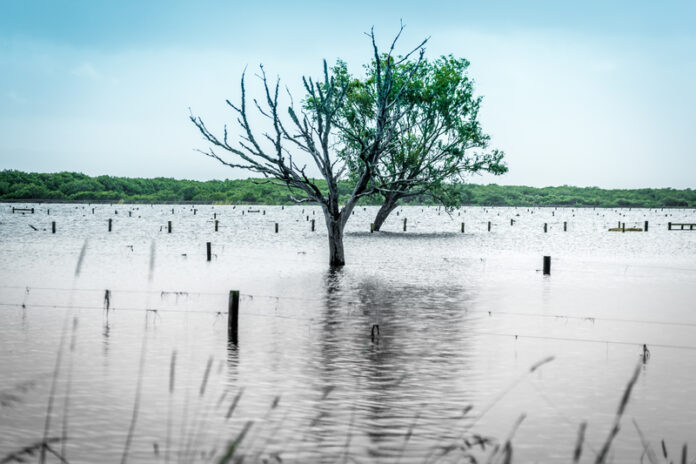
Just off the coast of Panama people are on the move. This month the Panamanian government started assisting 300 families on the island of Gardi Sugdub, a kilometre from the coast, to move to new homes on the mainland. Why? Because the island, which today lies roughly a half-metre (20 inches) above the Caribbean Sea, is being inundated as the water rises 3 to 4 millimetres per year. That doesn’t sound like a lot compared to a half-metre, but with storm surges it is proving to be disastrous. By 2100, the island will have almost disappeared. It along with 50 others in the Guna Yala archipelago face the consequences of climate change as ocean thermal expansion and melting polar ice cause sea levels to rise.
The move to mainland Panama has been long in planning with financial and technical support in place from the Inter-American Development Bank. The 300 families will live in a new community that has been built for them. It is called Isber Yala and lies on the coast within view of their old home. It isn’t quite finished with the unavailability of electricity still a challenge. But the village homes are better than what they were living in on Gardi Sugdub.
Some islanders are staying. They don’t want to leave their homes. But the rising seas will eventually claim them. A June 1, 2024 article appearing in The Christian Science Monitor quotes Steven Paton, Director of the Smithsonian Institution’s physical monitoring program in Panama, who describes their plight. Paton points to the current move as “a direct consequence of climate change through the increase in sea level…the Gunas are going to have to abandon all of the islands almost surely by the end of the century or earlier.” He continues, “All of the world’s coasts are being affected by this at different speeds.”
People are moving inland or away from island homes in many places on the planet. It is happening on Pacific and Indian Ocean islands. It is happening on the Mexican coastline, in Italy, New Zealand, Bangladesh and the United States.
In South Florida, sea levels rose 0.3 metres (12 inches) in the last 80 years. A third of that rise has happened in the last 30 years. Brian McNoldy, a research associate at the University of Miami’s Rosenstiel School of Marine, Atmospheric and Earth Science notes that the rise is speeding up.
Joining the Panamanian island exodus are citizens of Pacific and Indian Ocean island nations who are already experiencing inundations. Some of these small countries are planning to move their entire populations to places hundreds of kilometres from their sinking homes. They have bought land in other countries for resettlement.
The National Oceanic and Atmospheric Administration (NOAA) tracks sea level rise and even its projections aren’t matching reality. The seas off Florida’s coasts are rising faster, as much as 0.6 metres (2 feet) forecasted by 2060 when compared to today. For the City of Miami with an average elevation of less than a metre (3 feet), retreat is not in the cards for the short term. The city and state are fending off the rising seas by spending tens of billions of dollars.
To further complicate Miami’s future is subsidence. South Florida is sinking and although the decline in elevation is tiny, in combination with rising seas, it doesn’t bode well for a state whose population is growing faster than anywhere else in the U.S. This influx of new Floridians with a propensity to live on the coast will put more Americans at risk because of climate-change-producing sea level rise, high tides and storm surges from hurricanes.
NASA whose Cape Canaveral facilities lie on Florida’s Atlantic coast is keenly aware of the threat. The agency is relocating structures to higher ground and building dunes and shoreline obstructions. It is installing flood-resistant doors in some structures in the hope that they can withstand storm surges and high tide-induced flooding.
Meanwhile, NASA Earth-observing satellites are tracking sea level rise around the world and at home. In the U.S., the entire coastline from Maine on the Atlantic Ocean to Texas on the Gulf of Mexico is under threat. Anywhere relatively low, flat land abuts shallow water, the risks are great. NASA forecasts that beyond 2100, sea level rise around the world may force communities along coastlines to retreat to higher ground. It projects rising sea levels after 2100 between 1 and 2 metres (3 to 6.5 feet) will cause widespread coastal damage. By 2150, it projects storm surges to be twice as high as they are today. The strategic adaptations being attempted in Florida by NASA and the City of Miami may help in the short term. Hardening coastal infrastructure and building up dunes and seawalls, however, will only be a stopgap.
What the people on Gardi Sugdub are experiencing now will be a far more common occurrence by the end of the century. We can mitigate it if we can stop putting greenhouse gas emissions into the atmosphere which means stopping the burning of fossil fuels. The great unknown states McNoldy is human behaviour. If we can slow down or stop releasing greenhouse gasses we can keep the rise to the lower thresholds indicated by forecasters. It will still mean significant population displacement and disruption but at a more manageable level and cost.








